Taxation Law: Analysis of Aussie Ltd. and James' Expenses (TAX201)
VerifiedAdded on 2020/03/23
|14
|3469
|95
Report
AI Summary
This report delves into the tax implications for Aussie Ltd. and James, addressing key issues related to Australian taxation law. For Aussie Ltd., the report examines the company's residency status, the assessability of its income, and the deductibility of its expenses, including a $2 million marketing operation. It analyzes whether Aussie Ltd. meets the criteria to be considered an Australian resident, and whether its income is subject to tax under the Income Tax Assessment Act 1997. The report also considers the deductibility of various expenses, such as marketing costs and redundancy payments, in light of the 'positive' and 'negative limbs' of Section 8-1 of the ITAA 1997. For James, the report assesses the deductibility of expenses incurred for property maintenance, including painting, roofing, plumbing, and pest control, focusing on whether these expenses are capital or revenue in nature. The analysis references relevant sections of the Income Tax Assessment Act and case law to support its conclusions, providing a comprehensive overview of the tax treatment of these specific scenarios.
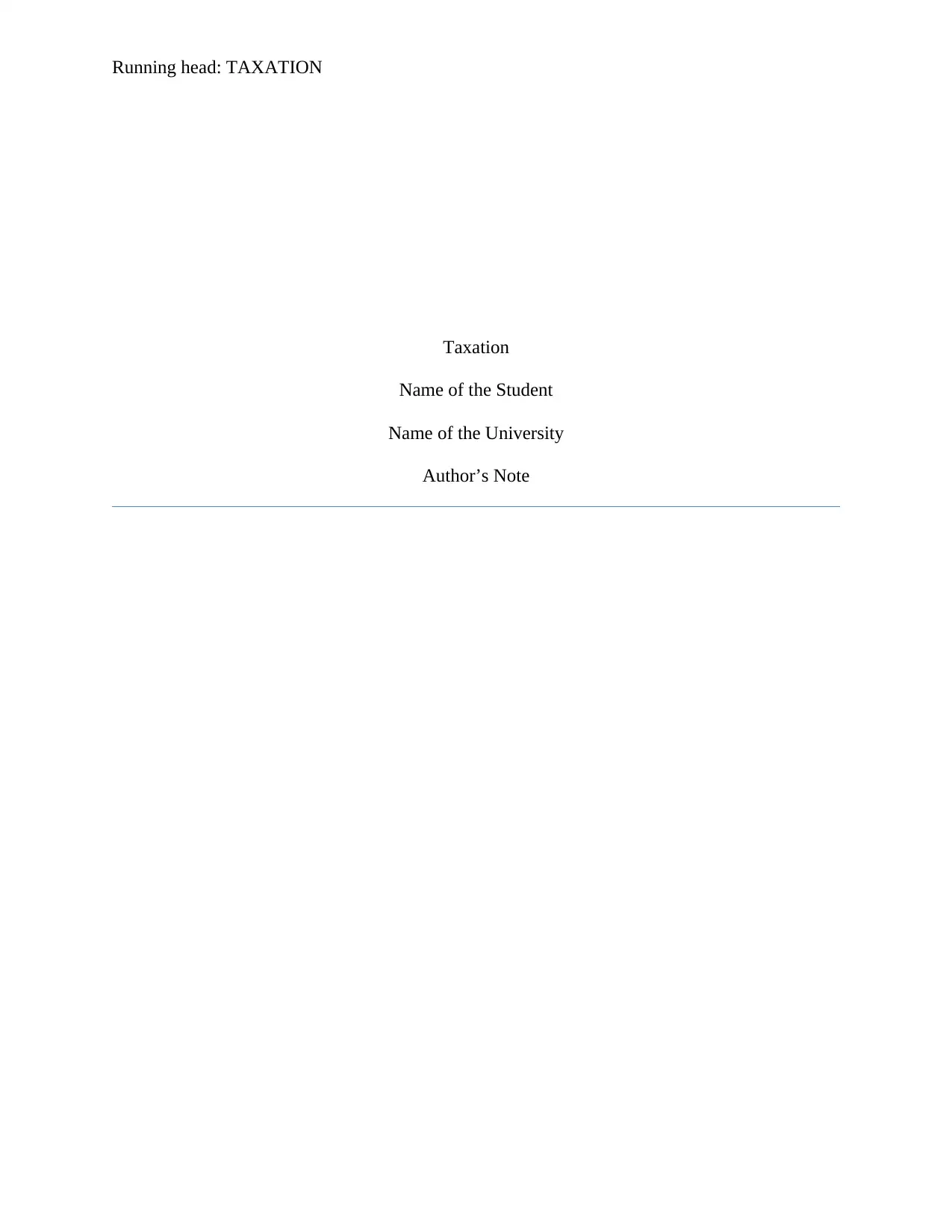
Running head: TAXATION
Taxation
Name of the Student
Name of the University
Author’s Note
Taxation
Name of the Student
Name of the University
Author’s Note
Paraphrase This Document
Need a fresh take? Get an instant paraphrase of this document with our AI Paraphraser
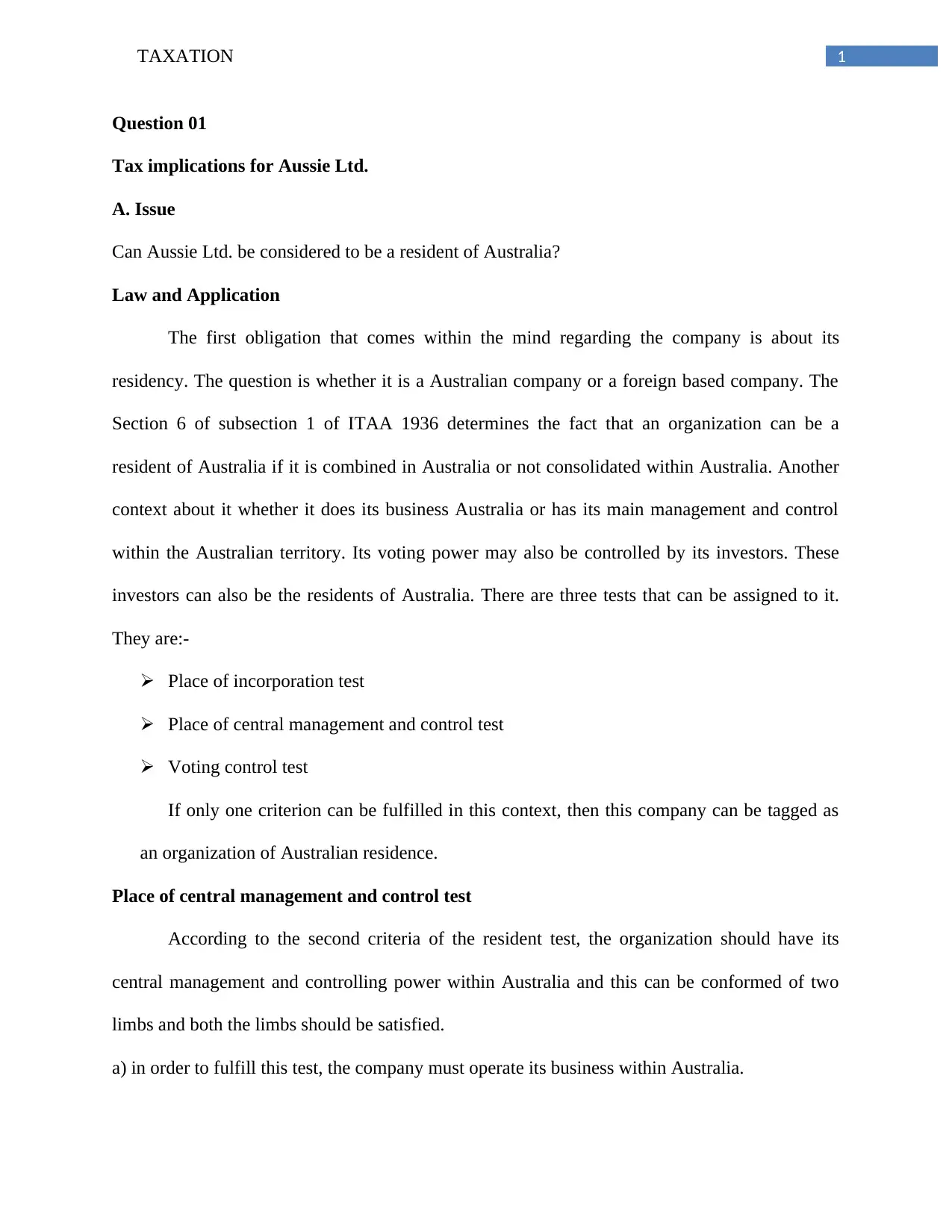
1TAXATION
Question 01
Tax implications for Aussie Ltd.
A. Issue
Can Aussie Ltd. be considered to be a resident of Australia?
Law and Application
The first obligation that comes within the mind regarding the company is about its
residency. The question is whether it is a Australian company or a foreign based company. The
Section 6 of subsection 1 of ITAA 1936 determines the fact that an organization can be a
resident of Australia if it is combined in Australia or not consolidated within Australia. Another
context about it whether it does its business Australia or has its main management and control
within the Australian territory. Its voting power may also be controlled by its investors. These
investors can also be the residents of Australia. There are three tests that can be assigned to it.
They are:-
Place of incorporation test
Place of central management and control test
Voting control test
If only one criterion can be fulfilled in this context, then this company can be tagged as
an organization of Australian residence.
Place of central management and control test
According to the second criteria of the resident test, the organization should have its
central management and controlling power within Australia and this can be conformed of two
limbs and both the limbs should be satisfied.
a) in order to fulfill this test, the company must operate its business within Australia.
Question 01
Tax implications for Aussie Ltd.
A. Issue
Can Aussie Ltd. be considered to be a resident of Australia?
Law and Application
The first obligation that comes within the mind regarding the company is about its
residency. The question is whether it is a Australian company or a foreign based company. The
Section 6 of subsection 1 of ITAA 1936 determines the fact that an organization can be a
resident of Australia if it is combined in Australia or not consolidated within Australia. Another
context about it whether it does its business Australia or has its main management and control
within the Australian territory. Its voting power may also be controlled by its investors. These
investors can also be the residents of Australia. There are three tests that can be assigned to it.
They are:-
Place of incorporation test
Place of central management and control test
Voting control test
If only one criterion can be fulfilled in this context, then this company can be tagged as
an organization of Australian residence.
Place of central management and control test
According to the second criteria of the resident test, the organization should have its
central management and controlling power within Australia and this can be conformed of two
limbs and both the limbs should be satisfied.
a) in order to fulfill this test, the company must operate its business within Australia.
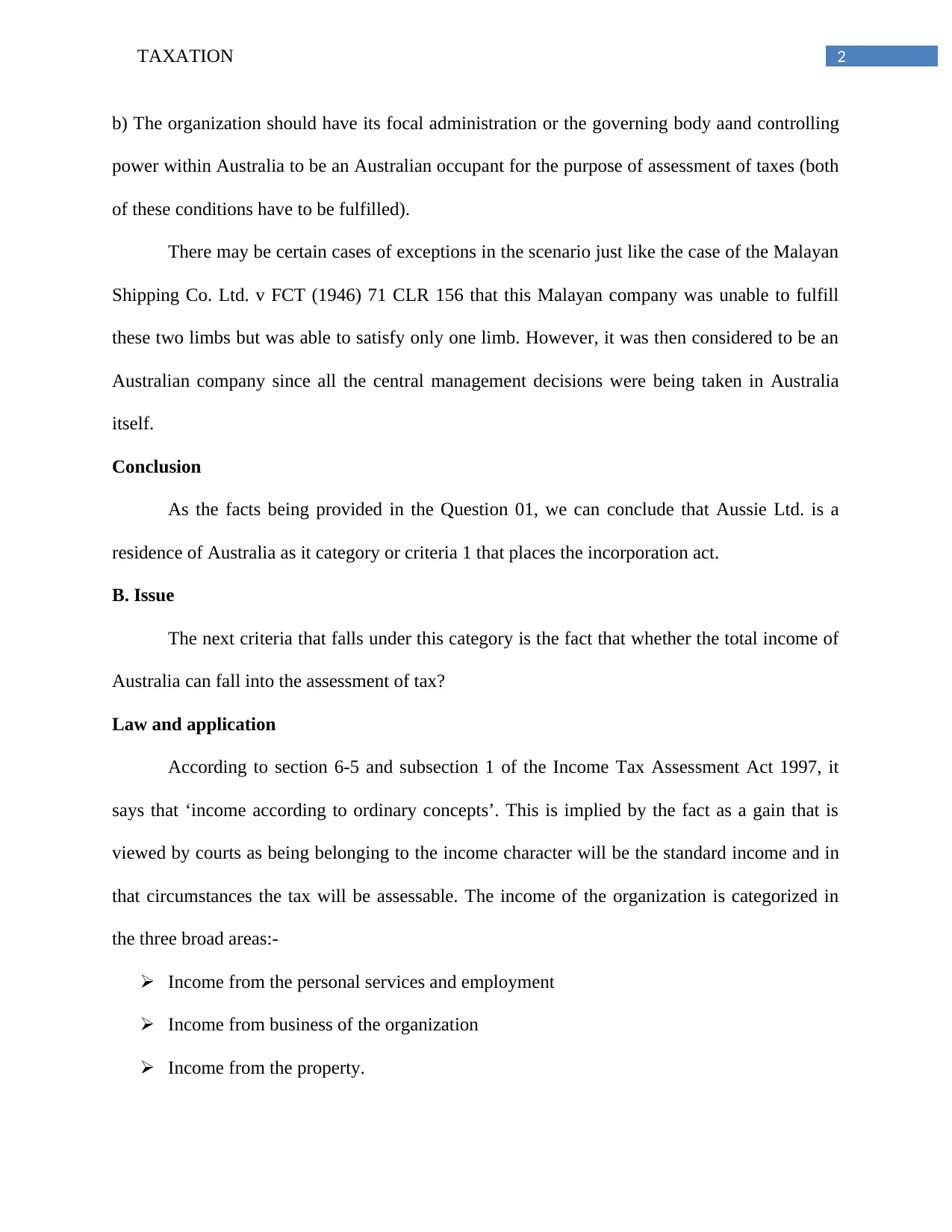
2TAXATION
b) The organization should have its focal administration or the governing body aand controlling
power within Australia to be an Australian occupant for the purpose of assessment of taxes (both
of these conditions have to be fulfilled).
There may be certain cases of exceptions in the scenario just like the case of the Malayan
Shipping Co. Ltd. v FCT (1946) 71 CLR 156 that this Malayan company was unable to fulfill
these two limbs but was able to satisfy only one limb. However, it was then considered to be an
Australian company since all the central management decisions were being taken in Australia
itself.
Conclusion
As the facts being provided in the Question 01, we can conclude that Aussie Ltd. is a
residence of Australia as it category or criteria 1 that places the incorporation act.
B. Issue
The next criteria that falls under this category is the fact that whether the total income of
Australia can fall into the assessment of tax?
Law and application
According to section 6-5 and subsection 1 of the Income Tax Assessment Act 1997, it
says that ‘income according to ordinary concepts’. This is implied by the fact as a gain that is
viewed by courts as being belonging to the income character will be the standard income and in
that circumstances the tax will be assessable. The income of the organization is categorized in
the three broad areas:-
Income from the personal services and employment
Income from business of the organization
Income from the property.
b) The organization should have its focal administration or the governing body aand controlling
power within Australia to be an Australian occupant for the purpose of assessment of taxes (both
of these conditions have to be fulfilled).
There may be certain cases of exceptions in the scenario just like the case of the Malayan
Shipping Co. Ltd. v FCT (1946) 71 CLR 156 that this Malayan company was unable to fulfill
these two limbs but was able to satisfy only one limb. However, it was then considered to be an
Australian company since all the central management decisions were being taken in Australia
itself.
Conclusion
As the facts being provided in the Question 01, we can conclude that Aussie Ltd. is a
residence of Australia as it category or criteria 1 that places the incorporation act.
B. Issue
The next criteria that falls under this category is the fact that whether the total income of
Australia can fall into the assessment of tax?
Law and application
According to section 6-5 and subsection 1 of the Income Tax Assessment Act 1997, it
says that ‘income according to ordinary concepts’. This is implied by the fact as a gain that is
viewed by courts as being belonging to the income character will be the standard income and in
that circumstances the tax will be assessable. The income of the organization is categorized in
the three broad areas:-
Income from the personal services and employment
Income from business of the organization
Income from the property.
⊘ This is a preview!⊘
Do you want full access?
Subscribe today to unlock all pages.

Trusted by 1+ million students worldwide
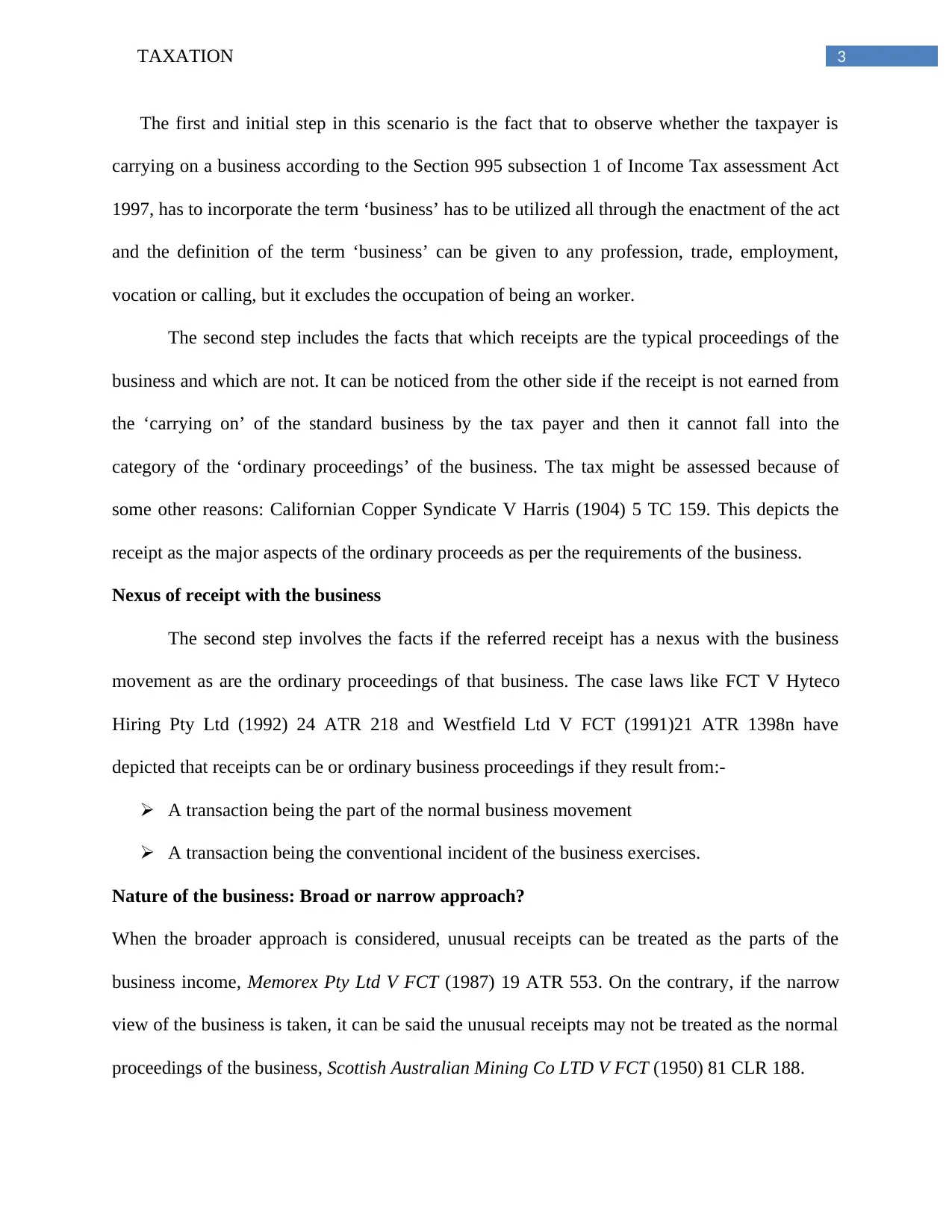
3TAXATION
The first and initial step in this scenario is the fact that to observe whether the taxpayer is
carrying on a business according to the Section 995 subsection 1 of Income Tax assessment Act
1997, has to incorporate the term ‘business’ has to be utilized all through the enactment of the act
and the definition of the term ‘business’ can be given to any profession, trade, employment,
vocation or calling, but it excludes the occupation of being an worker.
The second step includes the facts that which receipts are the typical proceedings of the
business and which are not. It can be noticed from the other side if the receipt is not earned from
the ‘carrying on’ of the standard business by the tax payer and then it cannot fall into the
category of the ‘ordinary proceedings’ of the business. The tax might be assessed because of
some other reasons: Californian Copper Syndicate V Harris (1904) 5 TC 159. This depicts the
receipt as the major aspects of the ordinary proceeds as per the requirements of the business.
Nexus of receipt with the business
The second step involves the facts if the referred receipt has a nexus with the business
movement as are the ordinary proceedings of that business. The case laws like FCT V Hyteco
Hiring Pty Ltd (1992) 24 ATR 218 and Westfield Ltd V FCT (1991)21 ATR 1398n have
depicted that receipts can be or ordinary business proceedings if they result from:-
A transaction being the part of the normal business movement
A transaction being the conventional incident of the business exercises.
Nature of the business: Broad or narrow approach?
When the broader approach is considered, unusual receipts can be treated as the parts of the
business income, Memorex Pty Ltd V FCT (1987) 19 ATR 553. On the contrary, if the narrow
view of the business is taken, it can be said the unusual receipts may not be treated as the normal
proceedings of the business, Scottish Australian Mining Co LTD V FCT (1950) 81 CLR 188.
The first and initial step in this scenario is the fact that to observe whether the taxpayer is
carrying on a business according to the Section 995 subsection 1 of Income Tax assessment Act
1997, has to incorporate the term ‘business’ has to be utilized all through the enactment of the act
and the definition of the term ‘business’ can be given to any profession, trade, employment,
vocation or calling, but it excludes the occupation of being an worker.
The second step includes the facts that which receipts are the typical proceedings of the
business and which are not. It can be noticed from the other side if the receipt is not earned from
the ‘carrying on’ of the standard business by the tax payer and then it cannot fall into the
category of the ‘ordinary proceedings’ of the business. The tax might be assessed because of
some other reasons: Californian Copper Syndicate V Harris (1904) 5 TC 159. This depicts the
receipt as the major aspects of the ordinary proceeds as per the requirements of the business.
Nexus of receipt with the business
The second step involves the facts if the referred receipt has a nexus with the business
movement as are the ordinary proceedings of that business. The case laws like FCT V Hyteco
Hiring Pty Ltd (1992) 24 ATR 218 and Westfield Ltd V FCT (1991)21 ATR 1398n have
depicted that receipts can be or ordinary business proceedings if they result from:-
A transaction being the part of the normal business movement
A transaction being the conventional incident of the business exercises.
Nature of the business: Broad or narrow approach?
When the broader approach is considered, unusual receipts can be treated as the parts of the
business income, Memorex Pty Ltd V FCT (1987) 19 ATR 553. On the contrary, if the narrow
view of the business is taken, it can be said the unusual receipts may not be treated as the normal
proceedings of the business, Scottish Australian Mining Co LTD V FCT (1950) 81 CLR 188.
Paraphrase This Document
Need a fresh take? Get an instant paraphrase of this document with our AI Paraphraser
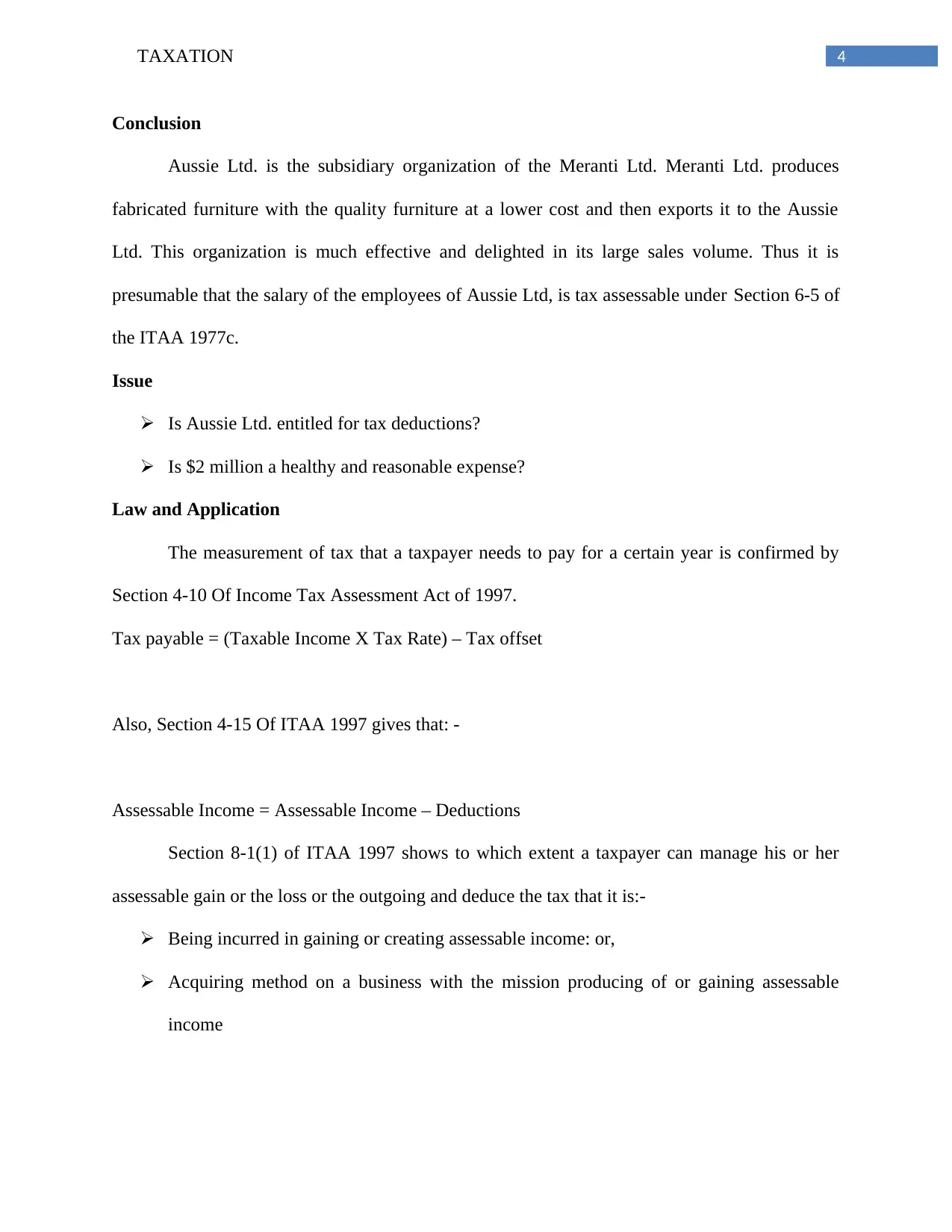
4TAXATION
Conclusion
Aussie Ltd. is the subsidiary organization of the Meranti Ltd. Meranti Ltd. produces
fabricated furniture with the quality furniture at a lower cost and then exports it to the Aussie
Ltd. This organization is much effective and delighted in its large sales volume. Thus it is
presumable that the salary of the employees of Aussie Ltd, is tax assessable under Section 6-5 of
the ITAA 1977c.
Issue
Is Aussie Ltd. entitled for tax deductions?
Is $2 million a healthy and reasonable expense?
Law and Application
The measurement of tax that a taxpayer needs to pay for a certain year is confirmed by
Section 4-10 Of Income Tax Assessment Act of 1997.
Tax payable = (Taxable Income X Tax Rate) – Tax offset
Also, Section 4-15 Of ITAA 1997 gives that: -
Assessable Income = Assessable Income – Deductions
Section 8-1(1) of ITAA 1997 shows to which extent a taxpayer can manage his or her
assessable gain or the loss or the outgoing and deduce the tax that it is:-
Being incurred in gaining or creating assessable income: or,
Acquiring method on a business with the mission producing of or gaining assessable
income
Conclusion
Aussie Ltd. is the subsidiary organization of the Meranti Ltd. Meranti Ltd. produces
fabricated furniture with the quality furniture at a lower cost and then exports it to the Aussie
Ltd. This organization is much effective and delighted in its large sales volume. Thus it is
presumable that the salary of the employees of Aussie Ltd, is tax assessable under Section 6-5 of
the ITAA 1977c.
Issue
Is Aussie Ltd. entitled for tax deductions?
Is $2 million a healthy and reasonable expense?
Law and Application
The measurement of tax that a taxpayer needs to pay for a certain year is confirmed by
Section 4-10 Of Income Tax Assessment Act of 1997.
Tax payable = (Taxable Income X Tax Rate) – Tax offset
Also, Section 4-15 Of ITAA 1997 gives that: -
Assessable Income = Assessable Income – Deductions
Section 8-1(1) of ITAA 1997 shows to which extent a taxpayer can manage his or her
assessable gain or the loss or the outgoing and deduce the tax that it is:-
Being incurred in gaining or creating assessable income: or,
Acquiring method on a business with the mission producing of or gaining assessable
income
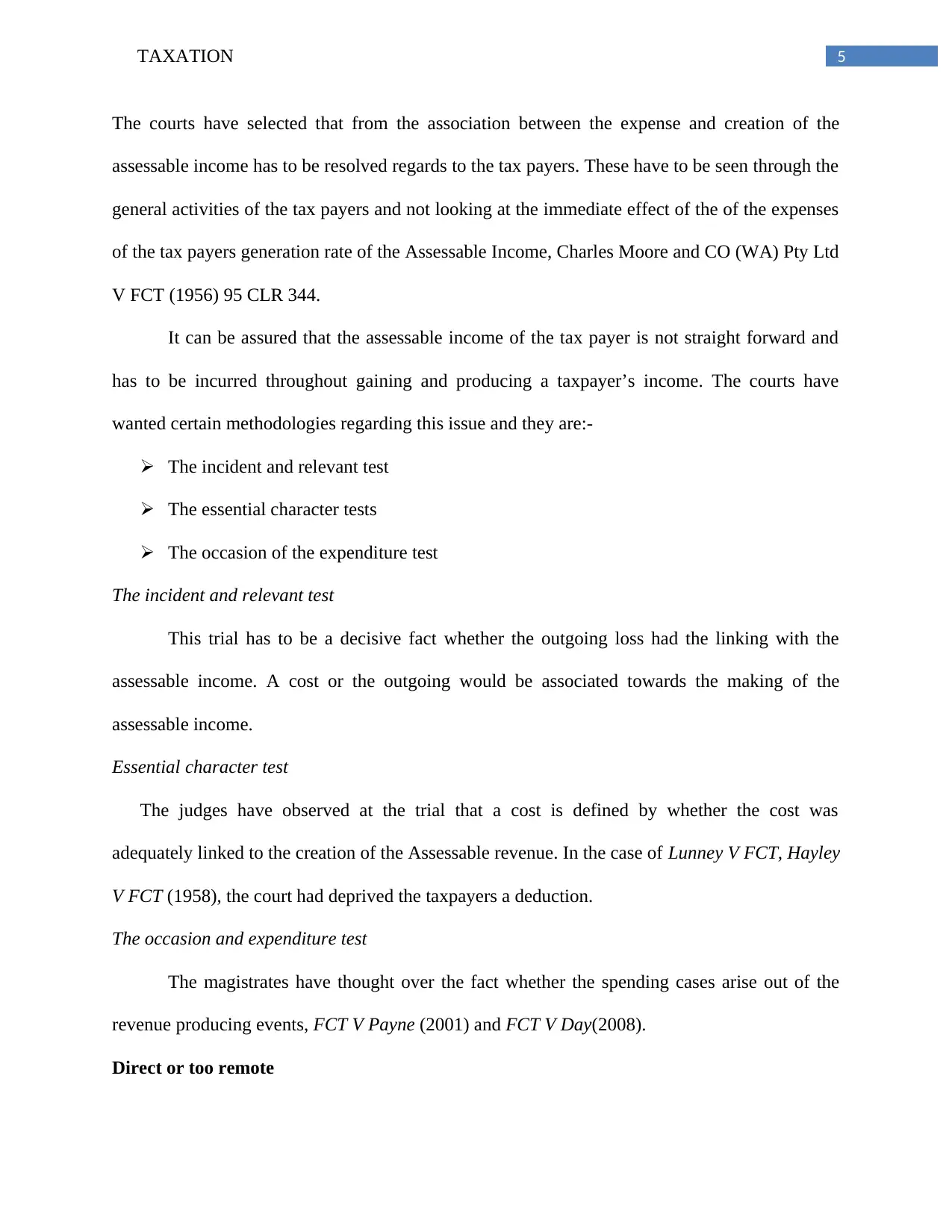
5TAXATION
The courts have selected that from the association between the expense and creation of the
assessable income has to be resolved regards to the tax payers. These have to be seen through the
general activities of the tax payers and not looking at the immediate effect of the of the expenses
of the tax payers generation rate of the Assessable Income, Charles Moore and CO (WA) Pty Ltd
V FCT (1956) 95 CLR 344.
It can be assured that the assessable income of the tax payer is not straight forward and
has to be incurred throughout gaining and producing a taxpayer’s income. The courts have
wanted certain methodologies regarding this issue and they are:-
The incident and relevant test
The essential character tests
The occasion of the expenditure test
The incident and relevant test
This trial has to be a decisive fact whether the outgoing loss had the linking with the
assessable income. A cost or the outgoing would be associated towards the making of the
assessable income.
Essential character test
The judges have observed at the trial that a cost is defined by whether the cost was
adequately linked to the creation of the Assessable revenue. In the case of Lunney V FCT, Hayley
V FCT (1958), the court had deprived the taxpayers a deduction.
The occasion and expenditure test
The magistrates have thought over the fact whether the spending cases arise out of the
revenue producing events, FCT V Payne (2001) and FCT V Day(2008).
Direct or too remote
The courts have selected that from the association between the expense and creation of the
assessable income has to be resolved regards to the tax payers. These have to be seen through the
general activities of the tax payers and not looking at the immediate effect of the of the expenses
of the tax payers generation rate of the Assessable Income, Charles Moore and CO (WA) Pty Ltd
V FCT (1956) 95 CLR 344.
It can be assured that the assessable income of the tax payer is not straight forward and
has to be incurred throughout gaining and producing a taxpayer’s income. The courts have
wanted certain methodologies regarding this issue and they are:-
The incident and relevant test
The essential character tests
The occasion of the expenditure test
The incident and relevant test
This trial has to be a decisive fact whether the outgoing loss had the linking with the
assessable income. A cost or the outgoing would be associated towards the making of the
assessable income.
Essential character test
The judges have observed at the trial that a cost is defined by whether the cost was
adequately linked to the creation of the Assessable revenue. In the case of Lunney V FCT, Hayley
V FCT (1958), the court had deprived the taxpayers a deduction.
The occasion and expenditure test
The magistrates have thought over the fact whether the spending cases arise out of the
revenue producing events, FCT V Payne (2001) and FCT V Day(2008).
Direct or too remote
⊘ This is a preview!⊘
Do you want full access?
Subscribe today to unlock all pages.

Trusted by 1+ million students worldwide
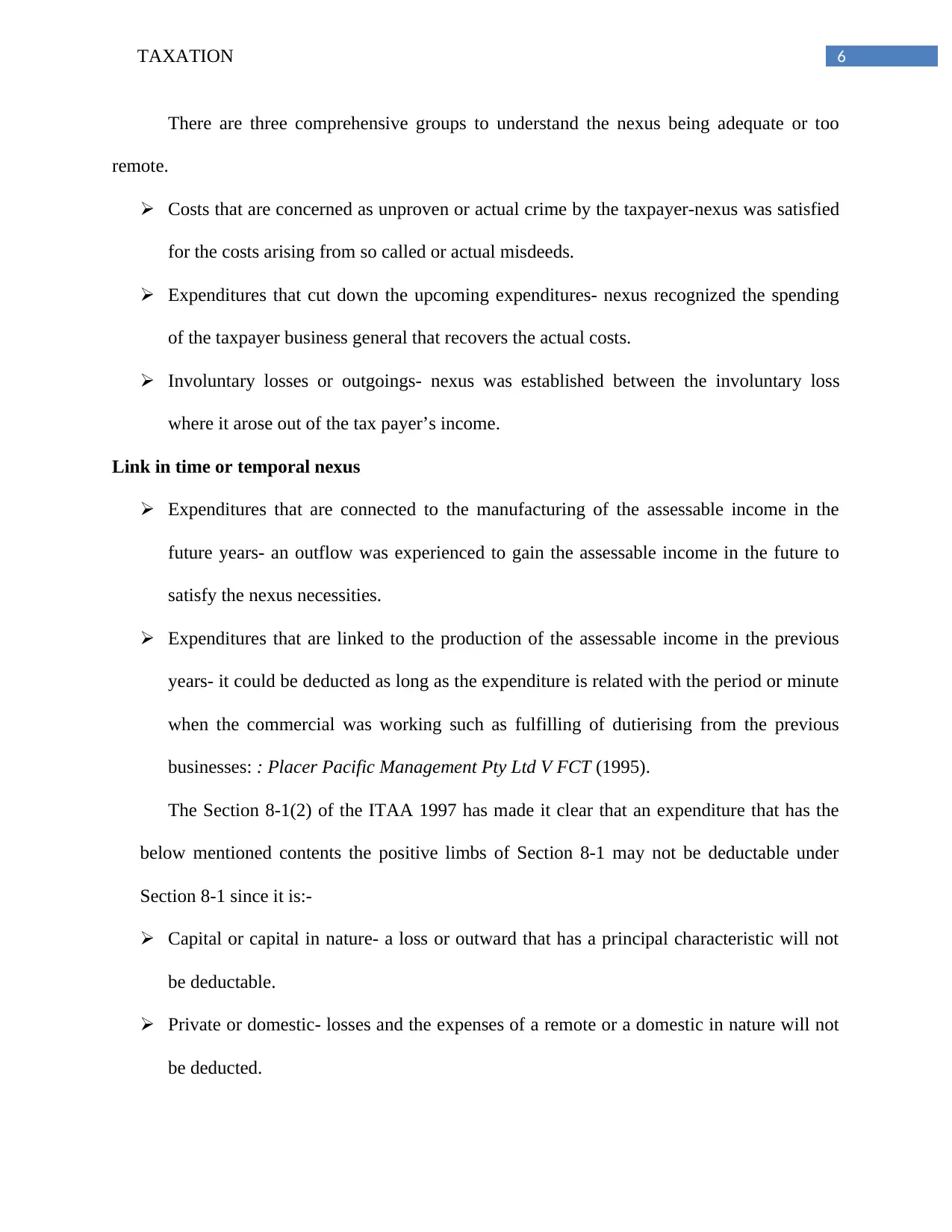
6TAXATION
There are three comprehensive groups to understand the nexus being adequate or too
remote.
Costs that are concerned as unproven or actual crime by the taxpayer-nexus was satisfied
for the costs arising from so called or actual misdeeds.
Expenditures that cut down the upcoming expenditures- nexus recognized the spending
of the taxpayer business general that recovers the actual costs.
Involuntary losses or outgoings- nexus was established between the involuntary loss
where it arose out of the tax payer’s income.
Link in time or temporal nexus
Expenditures that are connected to the manufacturing of the assessable income in the
future years- an outflow was experienced to gain the assessable income in the future to
satisfy the nexus necessities.
Expenditures that are linked to the production of the assessable income in the previous
years- it could be deducted as long as the expenditure is related with the period or minute
when the commercial was working such as fulfilling of dutierising from the previous
businesses: : Placer Pacific Management Pty Ltd V FCT (1995).
The Section 8-1(2) of the ITAA 1997 has made it clear that an expenditure that has the
below mentioned contents the positive limbs of Section 8-1 may not be deductable under
Section 8-1 since it is:-
Capital or capital in nature- a loss or outward that has a principal characteristic will not
be deductable.
Private or domestic- losses and the expenses of a remote or a domestic in nature will not
be deducted.
There are three comprehensive groups to understand the nexus being adequate or too
remote.
Costs that are concerned as unproven or actual crime by the taxpayer-nexus was satisfied
for the costs arising from so called or actual misdeeds.
Expenditures that cut down the upcoming expenditures- nexus recognized the spending
of the taxpayer business general that recovers the actual costs.
Involuntary losses or outgoings- nexus was established between the involuntary loss
where it arose out of the tax payer’s income.
Link in time or temporal nexus
Expenditures that are connected to the manufacturing of the assessable income in the
future years- an outflow was experienced to gain the assessable income in the future to
satisfy the nexus necessities.
Expenditures that are linked to the production of the assessable income in the previous
years- it could be deducted as long as the expenditure is related with the period or minute
when the commercial was working such as fulfilling of dutierising from the previous
businesses: : Placer Pacific Management Pty Ltd V FCT (1995).
The Section 8-1(2) of the ITAA 1997 has made it clear that an expenditure that has the
below mentioned contents the positive limbs of Section 8-1 may not be deductable under
Section 8-1 since it is:-
Capital or capital in nature- a loss or outward that has a principal characteristic will not
be deductable.
Private or domestic- losses and the expenses of a remote or a domestic in nature will not
be deducted.
Paraphrase This Document
Need a fresh take? Get an instant paraphrase of this document with our AI Paraphraser
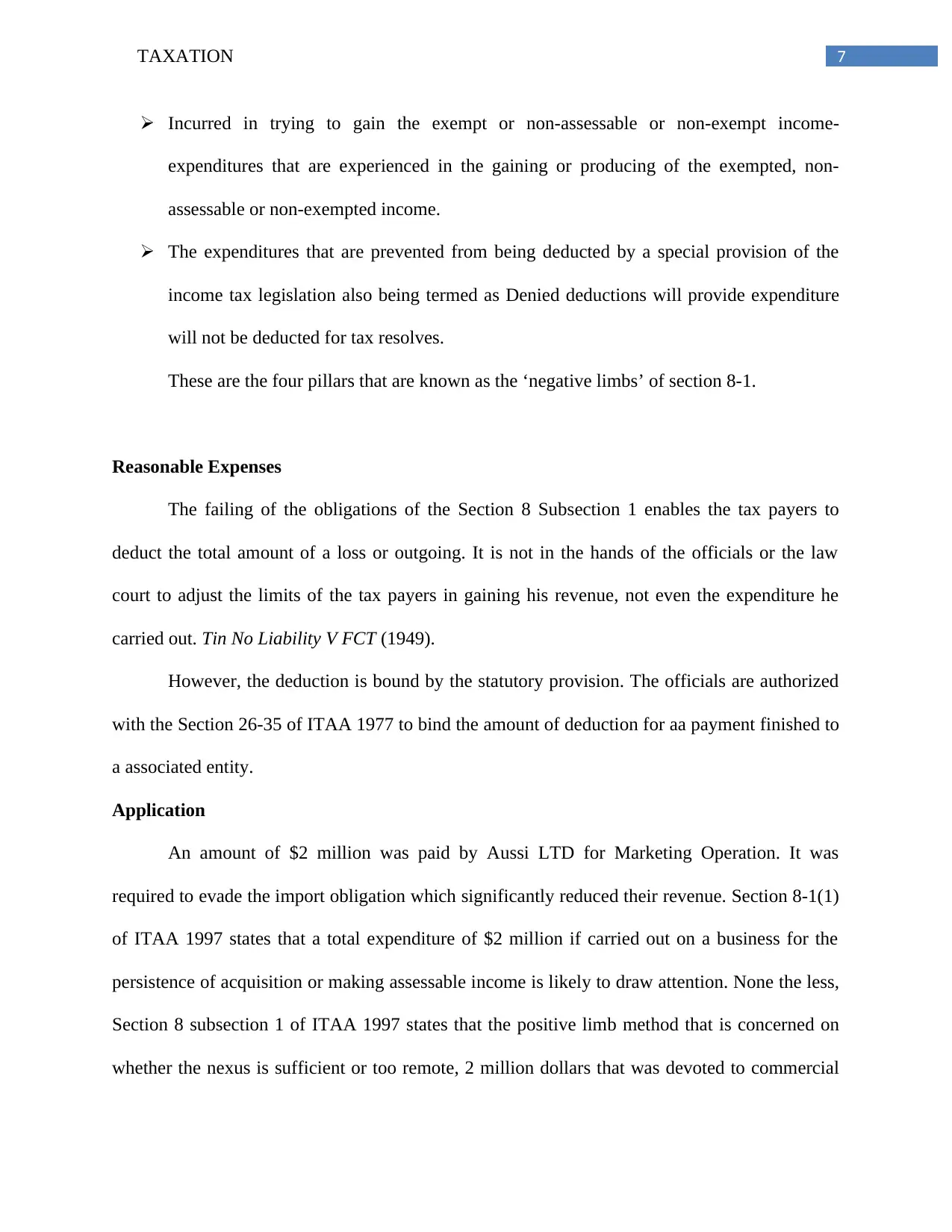
7TAXATION
Incurred in trying to gain the exempt or non-assessable or non-exempt income-
expenditures that are experienced in the gaining or producing of the exempted, non-
assessable or non-exempted income.
The expenditures that are prevented from being deducted by a special provision of the
income tax legislation also being termed as Denied deductions will provide expenditure
will not be deducted for tax resolves.
These are the four pillars that are known as the ‘negative limbs’ of section 8-1.
Reasonable Expenses
The failing of the obligations of the Section 8 Subsection 1 enables the tax payers to
deduct the total amount of a loss or outgoing. It is not in the hands of the officials or the law
court to adjust the limits of the tax payers in gaining his revenue, not even the expenditure he
carried out. Tin No Liability V FCT (1949).
However, the deduction is bound by the statutory provision. The officials are authorized
with the Section 26-35 of ITAA 1977 to bind the amount of deduction for aa payment finished to
a associated entity.
Application
An amount of $2 million was paid by Aussi LTD for Marketing Operation. It was
required to evade the import obligation which significantly reduced their revenue. Section 8-1(1)
of ITAA 1997 states that a total expenditure of $2 million if carried out on a business for the
persistence of acquisition or making assessable income is likely to draw attention. None the less,
Section 8 subsection 1 of ITAA 1997 states that the positive limb method that is concerned on
whether the nexus is sufficient or too remote, 2 million dollars that was devoted to commercial
Incurred in trying to gain the exempt or non-assessable or non-exempt income-
expenditures that are experienced in the gaining or producing of the exempted, non-
assessable or non-exempted income.
The expenditures that are prevented from being deducted by a special provision of the
income tax legislation also being termed as Denied deductions will provide expenditure
will not be deducted for tax resolves.
These are the four pillars that are known as the ‘negative limbs’ of section 8-1.
Reasonable Expenses
The failing of the obligations of the Section 8 Subsection 1 enables the tax payers to
deduct the total amount of a loss or outgoing. It is not in the hands of the officials or the law
court to adjust the limits of the tax payers in gaining his revenue, not even the expenditure he
carried out. Tin No Liability V FCT (1949).
However, the deduction is bound by the statutory provision. The officials are authorized
with the Section 26-35 of ITAA 1977 to bind the amount of deduction for aa payment finished to
a associated entity.
Application
An amount of $2 million was paid by Aussi LTD for Marketing Operation. It was
required to evade the import obligation which significantly reduced their revenue. Section 8-1(1)
of ITAA 1997 states that a total expenditure of $2 million if carried out on a business for the
persistence of acquisition or making assessable income is likely to draw attention. None the less,
Section 8 subsection 1 of ITAA 1997 states that the positive limb method that is concerned on
whether the nexus is sufficient or too remote, 2 million dollars that was devoted to commercial
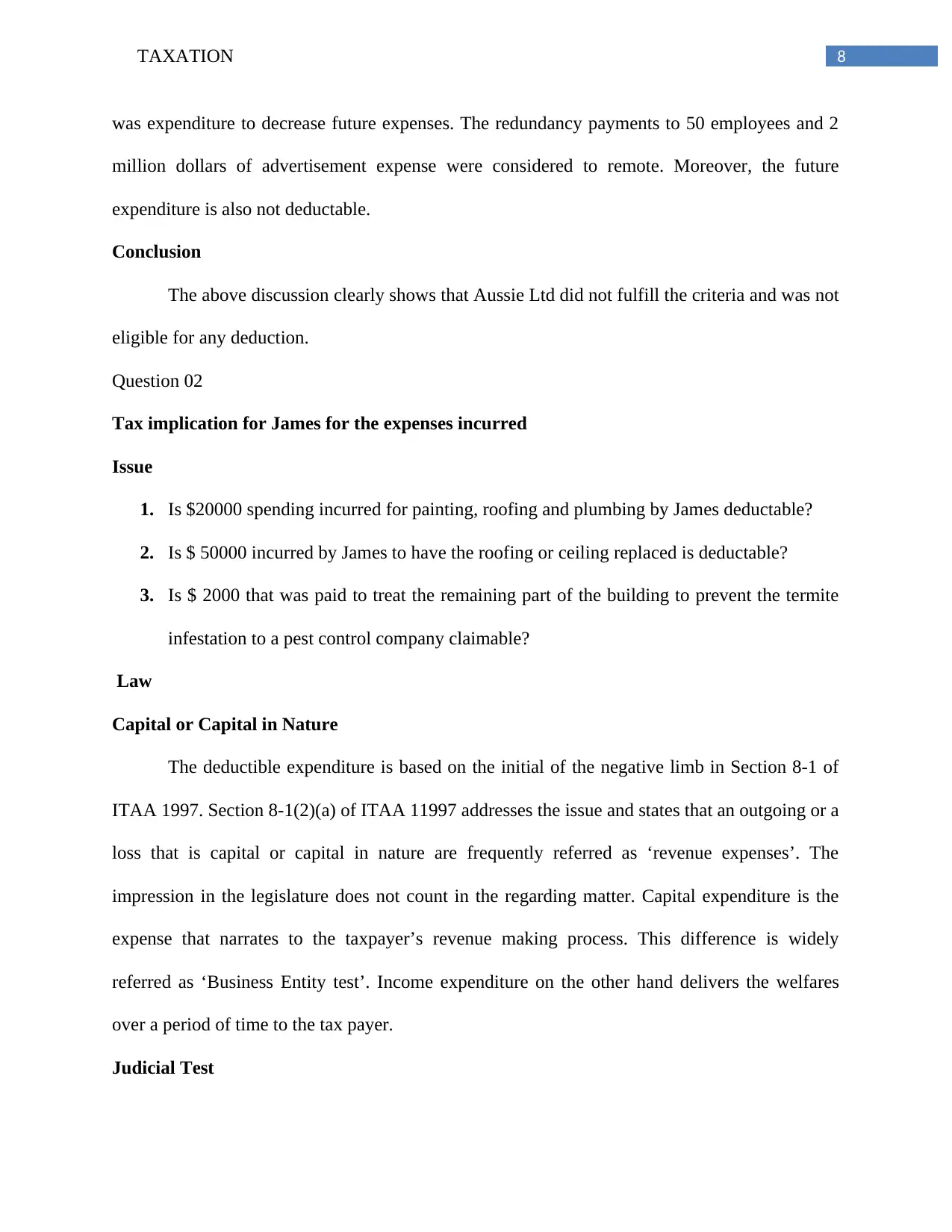
8TAXATION
was expenditure to decrease future expenses. The redundancy payments to 50 employees and 2
million dollars of advertisement expense were considered to remote. Moreover, the future
expenditure is also not deductable.
Conclusion
The above discussion clearly shows that Aussie Ltd did not fulfill the criteria and was not
eligible for any deduction.
Question 02
Tax implication for James for the expenses incurred
Issue
1. Is $20000 spending incurred for painting, roofing and plumbing by James deductable?
2. Is $ 50000 incurred by James to have the roofing or ceiling replaced is deductable?
3. Is $ 2000 that was paid to treat the remaining part of the building to prevent the termite
infestation to a pest control company claimable?
Law
Capital or Capital in Nature
The deductible expenditure is based on the initial of the negative limb in Section 8-1 of
ITAA 1997. Section 8-1(2)(a) of ITAA 11997 addresses the issue and states that an outgoing or a
loss that is capital or capital in nature are frequently referred as ‘revenue expenses’. The
impression in the legislature does not count in the regarding matter. Capital expenditure is the
expense that narrates to the taxpayer’s revenue making process. This difference is widely
referred as ‘Business Entity test’. Income expenditure on the other hand delivers the welfares
over a period of time to the tax payer.
Judicial Test
was expenditure to decrease future expenses. The redundancy payments to 50 employees and 2
million dollars of advertisement expense were considered to remote. Moreover, the future
expenditure is also not deductable.
Conclusion
The above discussion clearly shows that Aussie Ltd did not fulfill the criteria and was not
eligible for any deduction.
Question 02
Tax implication for James for the expenses incurred
Issue
1. Is $20000 spending incurred for painting, roofing and plumbing by James deductable?
2. Is $ 50000 incurred by James to have the roofing or ceiling replaced is deductable?
3. Is $ 2000 that was paid to treat the remaining part of the building to prevent the termite
infestation to a pest control company claimable?
Law
Capital or Capital in Nature
The deductible expenditure is based on the initial of the negative limb in Section 8-1 of
ITAA 1997. Section 8-1(2)(a) of ITAA 11997 addresses the issue and states that an outgoing or a
loss that is capital or capital in nature are frequently referred as ‘revenue expenses’. The
impression in the legislature does not count in the regarding matter. Capital expenditure is the
expense that narrates to the taxpayer’s revenue making process. This difference is widely
referred as ‘Business Entity test’. Income expenditure on the other hand delivers the welfares
over a period of time to the tax payer.
Judicial Test
⊘ This is a preview!⊘
Do you want full access?
Subscribe today to unlock all pages.

Trusted by 1+ million students worldwide
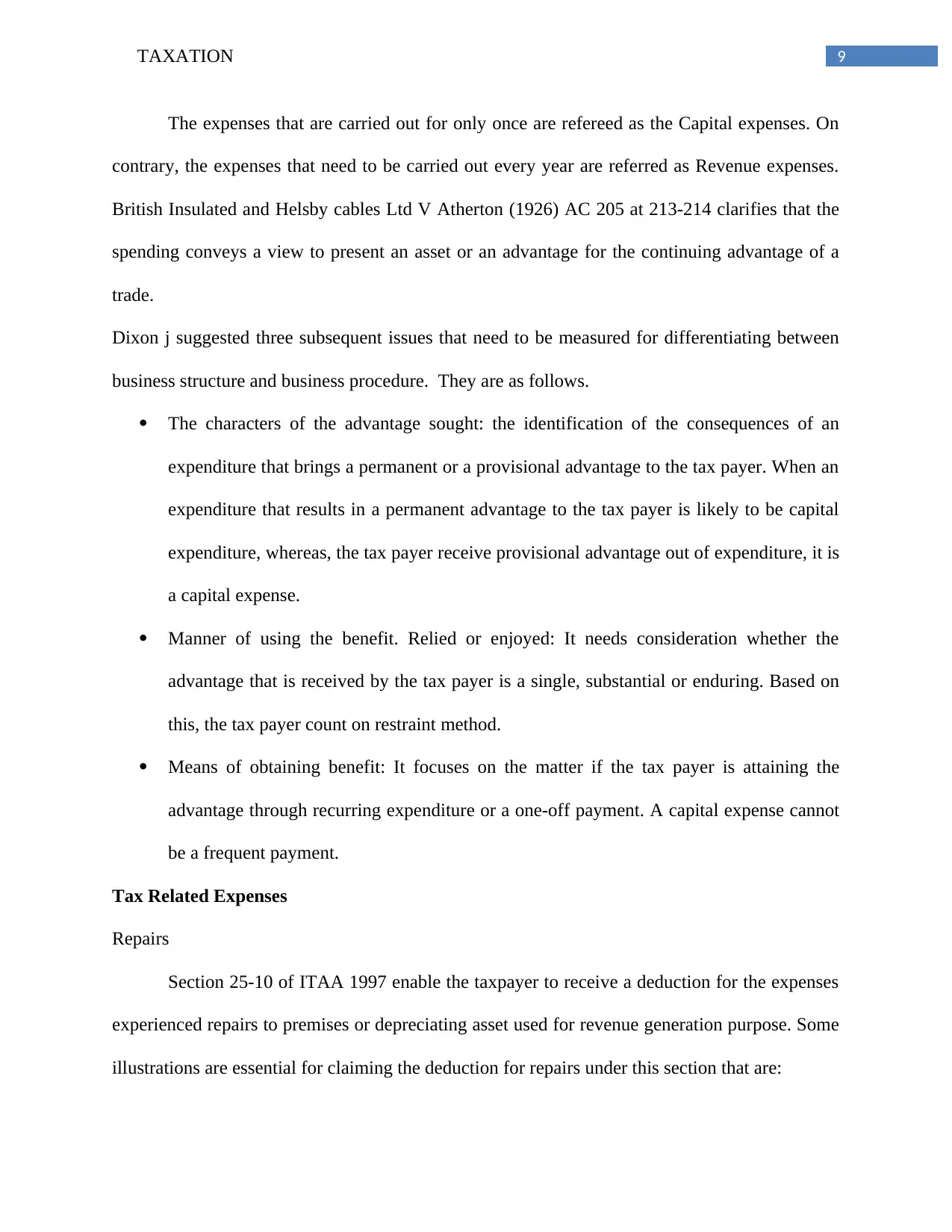
9TAXATION
The expenses that are carried out for only once are refereed as the Capital expenses. On
contrary, the expenses that need to be carried out every year are referred as Revenue expenses.
British Insulated and Helsby cables Ltd V Atherton (1926) AC 205 at 213-214 clarifies that the
spending conveys a view to present an asset or an advantage for the continuing advantage of a
trade.
Dixon j suggested three subsequent issues that need to be measured for differentiating between
business structure and business procedure. They are as follows.
The characters of the advantage sought: the identification of the consequences of an
expenditure that brings a permanent or a provisional advantage to the tax payer. When an
expenditure that results in a permanent advantage to the tax payer is likely to be capital
expenditure, whereas, the tax payer receive provisional advantage out of expenditure, it is
a capital expense.
Manner of using the benefit. Relied or enjoyed: It needs consideration whether the
advantage that is received by the tax payer is a single, substantial or enduring. Based on
this, the tax payer count on restraint method.
Means of obtaining benefit: It focuses on the matter if the tax payer is attaining the
advantage through recurring expenditure or a one-off payment. A capital expense cannot
be a frequent payment.
Tax Related Expenses
Repairs
Section 25-10 of ITAA 1997 enable the taxpayer to receive a deduction for the expenses
experienced repairs to premises or depreciating asset used for revenue generation purpose. Some
illustrations are essential for claiming the deduction for repairs under this section that are:
The expenses that are carried out for only once are refereed as the Capital expenses. On
contrary, the expenses that need to be carried out every year are referred as Revenue expenses.
British Insulated and Helsby cables Ltd V Atherton (1926) AC 205 at 213-214 clarifies that the
spending conveys a view to present an asset or an advantage for the continuing advantage of a
trade.
Dixon j suggested three subsequent issues that need to be measured for differentiating between
business structure and business procedure. They are as follows.
The characters of the advantage sought: the identification of the consequences of an
expenditure that brings a permanent or a provisional advantage to the tax payer. When an
expenditure that results in a permanent advantage to the tax payer is likely to be capital
expenditure, whereas, the tax payer receive provisional advantage out of expenditure, it is
a capital expense.
Manner of using the benefit. Relied or enjoyed: It needs consideration whether the
advantage that is received by the tax payer is a single, substantial or enduring. Based on
this, the tax payer count on restraint method.
Means of obtaining benefit: It focuses on the matter if the tax payer is attaining the
advantage through recurring expenditure or a one-off payment. A capital expense cannot
be a frequent payment.
Tax Related Expenses
Repairs
Section 25-10 of ITAA 1997 enable the taxpayer to receive a deduction for the expenses
experienced repairs to premises or depreciating asset used for revenue generation purpose. Some
illustrations are essential for claiming the deduction for repairs under this section that are:
Paraphrase This Document
Need a fresh take? Get an instant paraphrase of this document with our AI Paraphraser
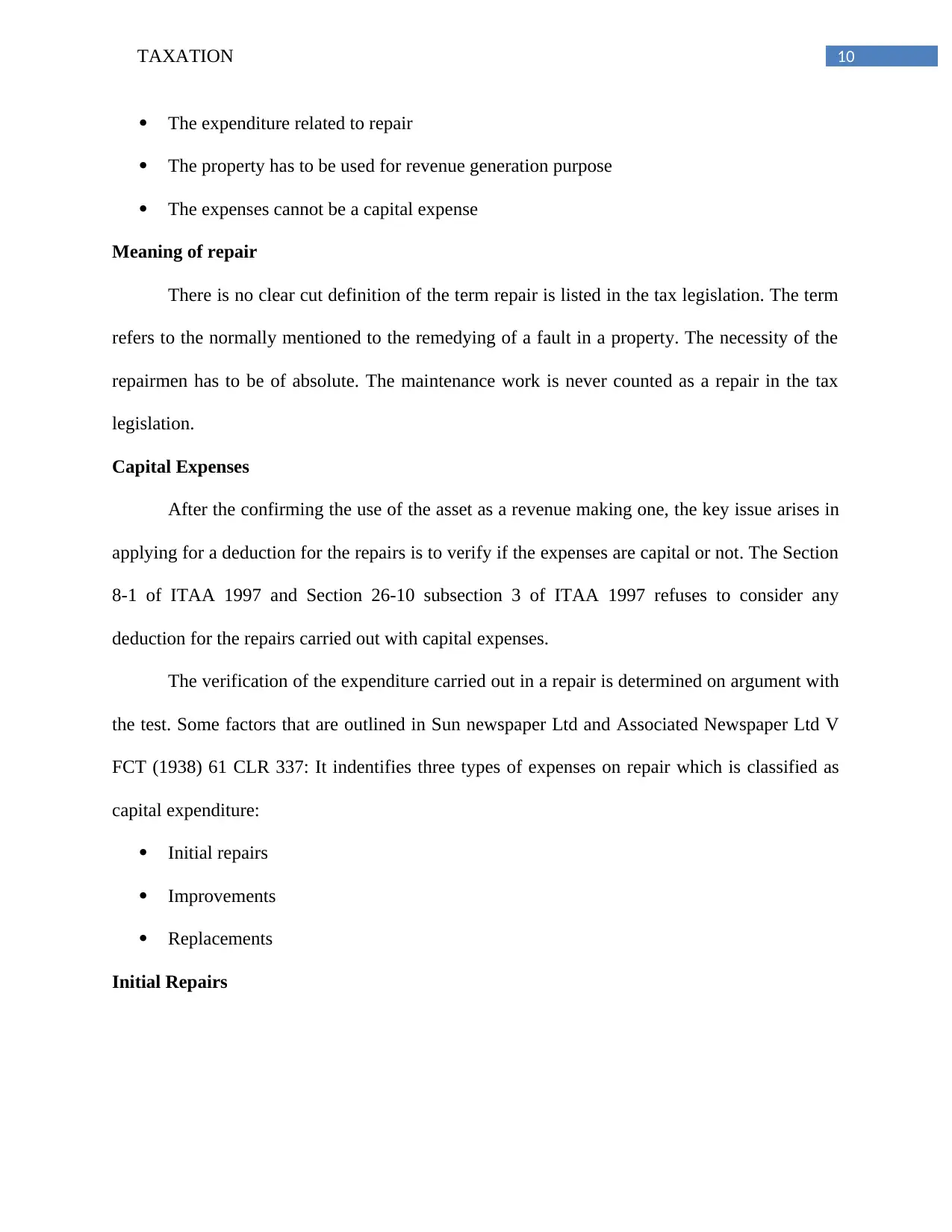
10TAXATION
The expenditure related to repair
The property has to be used for revenue generation purpose
The expenses cannot be a capital expense
Meaning of repair
There is no clear cut definition of the term repair is listed in the tax legislation. The term
refers to the normally mentioned to the remedying of a fault in a property. The necessity of the
repairmen has to be of absolute. The maintenance work is never counted as a repair in the tax
legislation.
Capital Expenses
After the confirming the use of the asset as a revenue making one, the key issue arises in
applying for a deduction for the repairs is to verify if the expenses are capital or not. The Section
8-1 of ITAA 1997 and Section 26-10 subsection 3 of ITAA 1997 refuses to consider any
deduction for the repairs carried out with capital expenses.
The verification of the expenditure carried out in a repair is determined on argument with
the test. Some factors that are outlined in Sun newspaper Ltd and Associated Newspaper Ltd V
FCT (1938) 61 CLR 337: It indentifies three types of expenses on repair which is classified as
capital expenditure:
Initial repairs
Improvements
Replacements
Initial Repairs
The expenditure related to repair
The property has to be used for revenue generation purpose
The expenses cannot be a capital expense
Meaning of repair
There is no clear cut definition of the term repair is listed in the tax legislation. The term
refers to the normally mentioned to the remedying of a fault in a property. The necessity of the
repairmen has to be of absolute. The maintenance work is never counted as a repair in the tax
legislation.
Capital Expenses
After the confirming the use of the asset as a revenue making one, the key issue arises in
applying for a deduction for the repairs is to verify if the expenses are capital or not. The Section
8-1 of ITAA 1997 and Section 26-10 subsection 3 of ITAA 1997 refuses to consider any
deduction for the repairs carried out with capital expenses.
The verification of the expenditure carried out in a repair is determined on argument with
the test. Some factors that are outlined in Sun newspaper Ltd and Associated Newspaper Ltd V
FCT (1938) 61 CLR 337: It indentifies three types of expenses on repair which is classified as
capital expenditure:
Initial repairs
Improvements
Replacements
Initial Repairs
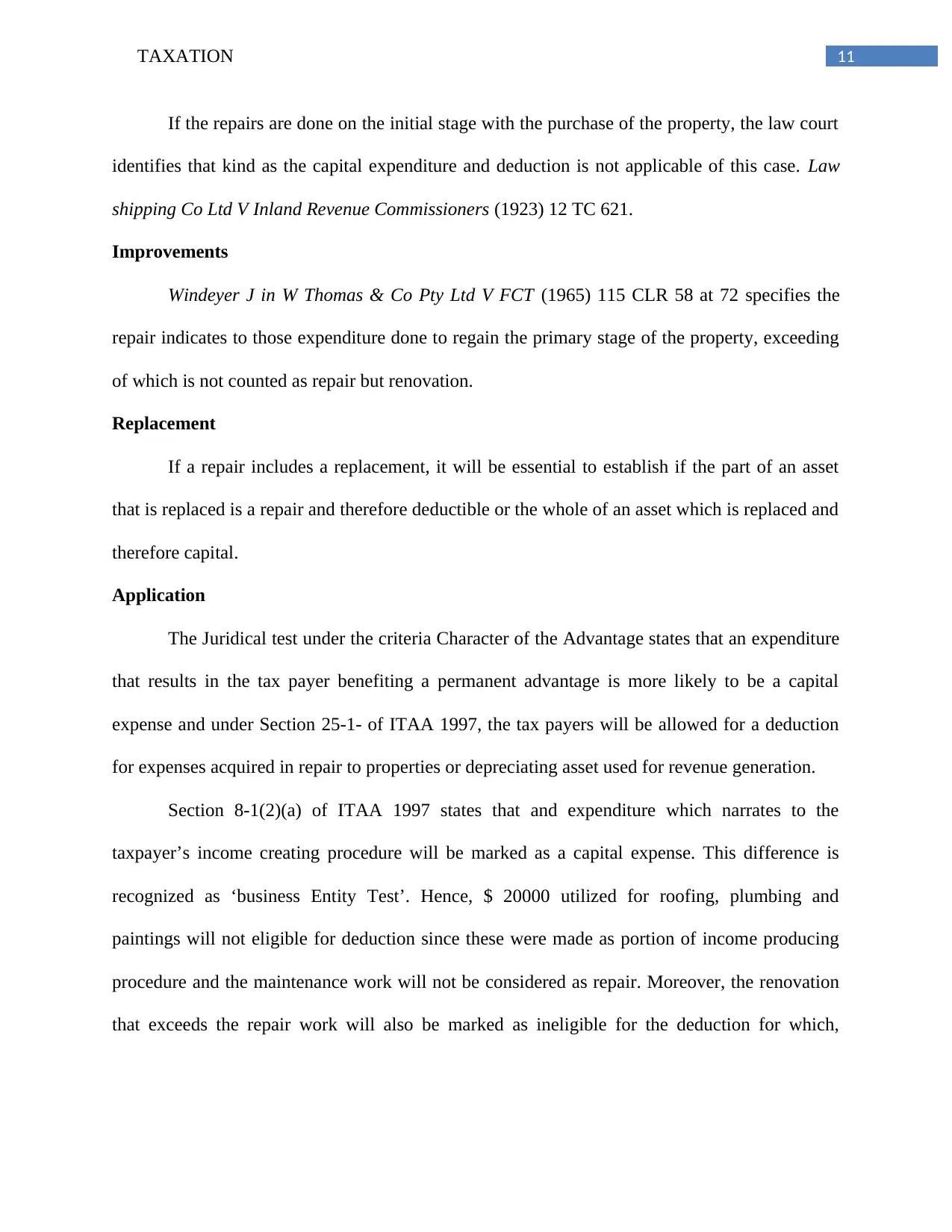
11TAXATION
If the repairs are done on the initial stage with the purchase of the property, the law court
identifies that kind as the capital expenditure and deduction is not applicable of this case. Law
shipping Co Ltd V Inland Revenue Commissioners (1923) 12 TC 621.
Improvements
Windeyer J in W Thomas & Co Pty Ltd V FCT (1965) 115 CLR 58 at 72 specifies the
repair indicates to those expenditure done to regain the primary stage of the property, exceeding
of which is not counted as repair but renovation.
Replacement
If a repair includes a replacement, it will be essential to establish if the part of an asset
that is replaced is a repair and therefore deductible or the whole of an asset which is replaced and
therefore capital.
Application
The Juridical test under the criteria Character of the Advantage states that an expenditure
that results in the tax payer benefiting a permanent advantage is more likely to be a capital
expense and under Section 25-1- of ITAA 1997, the tax payers will be allowed for a deduction
for expenses acquired in repair to properties or depreciating asset used for revenue generation.
Section 8-1(2)(a) of ITAA 1997 states that and expenditure which narrates to the
taxpayer’s income creating procedure will be marked as a capital expense. This difference is
recognized as ‘business Entity Test’. Hence, $ 20000 utilized for roofing, plumbing and
paintings will not eligible for deduction since these were made as portion of income producing
procedure and the maintenance work will not be considered as repair. Moreover, the renovation
that exceeds the repair work will also be marked as ineligible for the deduction for which,
If the repairs are done on the initial stage with the purchase of the property, the law court
identifies that kind as the capital expenditure and deduction is not applicable of this case. Law
shipping Co Ltd V Inland Revenue Commissioners (1923) 12 TC 621.
Improvements
Windeyer J in W Thomas & Co Pty Ltd V FCT (1965) 115 CLR 58 at 72 specifies the
repair indicates to those expenditure done to regain the primary stage of the property, exceeding
of which is not counted as repair but renovation.
Replacement
If a repair includes a replacement, it will be essential to establish if the part of an asset
that is replaced is a repair and therefore deductible or the whole of an asset which is replaced and
therefore capital.
Application
The Juridical test under the criteria Character of the Advantage states that an expenditure
that results in the tax payer benefiting a permanent advantage is more likely to be a capital
expense and under Section 25-1- of ITAA 1997, the tax payers will be allowed for a deduction
for expenses acquired in repair to properties or depreciating asset used for revenue generation.
Section 8-1(2)(a) of ITAA 1997 states that and expenditure which narrates to the
taxpayer’s income creating procedure will be marked as a capital expense. This difference is
recognized as ‘business Entity Test’. Hence, $ 20000 utilized for roofing, plumbing and
paintings will not eligible for deduction since these were made as portion of income producing
procedure and the maintenance work will not be considered as repair. Moreover, the renovation
that exceeds the repair work will also be marked as ineligible for the deduction for which,
⊘ This is a preview!⊘
Do you want full access?
Subscribe today to unlock all pages.

Trusted by 1+ million students worldwide
1 out of 14
Related Documents
Your All-in-One AI-Powered Toolkit for Academic Success.
+13062052269
info@desklib.com
Available 24*7 on WhatsApp / Email
![[object Object]](/_next/static/media/star-bottom.7253800d.svg)
Unlock your academic potential
Copyright © 2020–2025 A2Z Services. All Rights Reserved. Developed and managed by ZUCOL.





